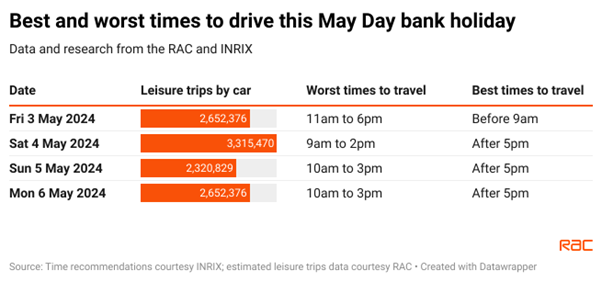The RAC is warning that 16 million drivers will hit the roads over the first bank holiday weekend of May, with tomorrow (Friday, May 3) expected to be the worse for hold-ups.
Analysis by the RAC and transport specialists Inrix suggests getaway traffic will start building on Friday before peaking on Saturday (May 4) at 3.3 million journeys.
A further 2.3m and 2.6m separate trips are planned on Sunday (May 5) and Monday (May 6), respectively.
In addition, 5.6m leisure trips are expected to be made at some point over the weekend by drivers still deciding which day to travel.
Inrix advises drivers to avoid setting off between 1pm and 7pm on Thursday, 11am and 6pm on Friday, 9am and 2pm on Saturday, and 10am and 3pm on both the Sunday and Monday.
Throughout the weekend, the best times to travel will be before 9am and after 5pm while Friday will be the worst day for hold-ups, with delays on major routes expected to take 13% longer than usual.
Inrix data also indicates that the long weekend may start as early as Thursday morning in some parts of the UK, with the M53 southbound from Liverpool to Chester hit by mid-morning delays of up to 45 minutes.
The busiest route will be the M5 southbound between Bristol and Taunton on Friday afternoon where travel is expected to take nearly two hours longer than usual due to getaway and commuter traffic combining.
Most major routes across the south and south-west are likely to take an average of 50% longer than usual to drive on Friday afternoon, while on bank holiday Monday itself, parts of the north-west, East Anglia and south-west will be hardest hit by returning traffic.
Jams are predicted on the M55 eastbound between Blackpool and Preston from 11am, Cornwall to Exeter eastbound on the A30 and A38 from 11.30am and Norwich to Thetford on the A11 southbound from 12.15pm.
Since 2017, RAC figures suggest 14m drivers tend to get away for a leisure journey at some point over the bank holiday weekend. This year’s total, in line with the last two years, is well above average.
RAC breakdown spokesperson Alice Simpson said: “Since 2022 – the first full year since mobility restrictions lifted – drivers appear to be much more eager to make the most of the May Day weekend, with the total number of get-away trips this year far exceeding the average since 2017.
“We’re anticipating a ‘crescendo of cars’ on the road over the weekend with as many as 3m motorists making leisure trips on Saturday alone.
“In addition to the majority of motorists planning day trips and short breaks, our data shows local routes to city and out-of-town shopping centres could see heavy traffic, so it’s best to head out early morning or evening if possible.”
She added: “For those extending their long weekend breaks into next week, it’s important to plan return journeys in advance as the train strikes between Tuesday (May 7) and Saturday (May 11) will inevitably lead to roads being busier.
“Industrial action can throw best-laid travel plans into chaos and many commuters who normally rely on the trains instead take to the roads, so our advice is to avoid driving at peak times of day if you can.”

Bob Pishue, transportation analyst at Inrix says that, although delays will not be as severe as Easter, drivers should expect the lengthiest hold-ups on major roads to and from popular destinations.
“Delays will likely peak on Friday afternoon with some areas seeing usual travel times double as holiday drivers vie for space on the roads with commuters,” he added.





















Login to comment
Comments
No comments have been made yet.